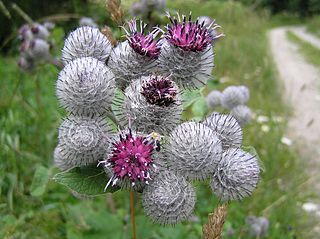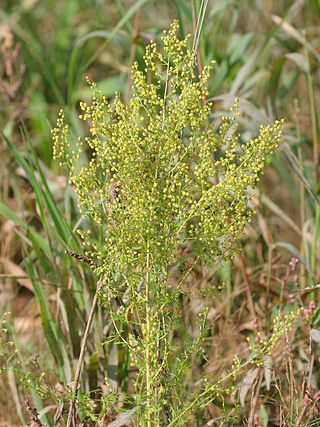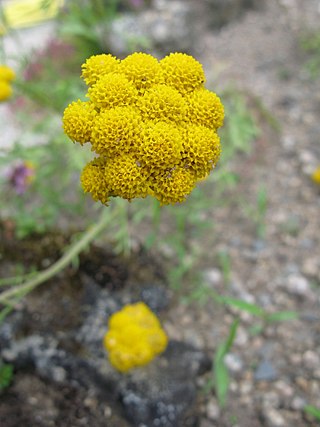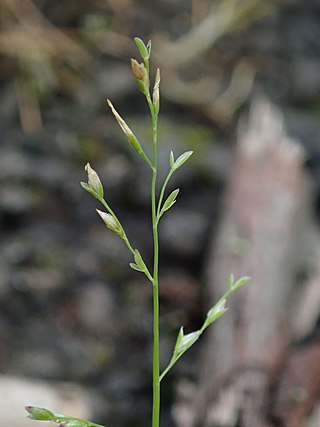
The potato is a starchy food, a tuber of the plant Solanum tuberosum and is a root vegetable native to the Americas. The plant is a perennial in the nightshade family Solanaceae.

Arctium is a genus of biennial plants commonly known as burdock, family Asteraceae. Native to Europe and Asia, several species have been widely introduced worldwide. Burdock's clinging properties, in addition to providing an excellent mechanism for seed dispersal, led to the invention of the hook and loop fastener.

Lunaria is a genus of flowering plants in the family Brassicaceae. It is native to Europe and has been introduced to North America and elsewhere. Species include:

Bellis is a genus of flowering plants in the family Asteraceae.

Poa pratensis, commonly known as Kentucky bluegrass, smooth meadow-grass, or common meadow-grass, is a perennial species of grass native to practically all of Europe, North Asia and the mountains of Algeria and Morocco. Although the species is spread over all of the cool, humid parts of the United States, it is not native to North America. The Spanish Empire brought the seeds of Kentucky bluegrass to the New World in mixtures with other grasses. In its native range, Poa pratensis forms a valuable pasture plant, characteristic of well-drained, fertile soil. It is also used for making lawns in parks and gardens and has established itself as a common invasive weed across cool moist temperate climates like the Pacific Northwest and the Northeastern United States. When found on native grasslands in Canada, for example, it is considered an unwelcome exotic plant, and is indicative of a disturbed and degraded landscape.

Dryas is a genus of perennial cushion-forming evergreen dwarf shrubs in the family Rosaceae, native to the arctic and alpine regions of Europe, Asia and North America. The genus is named after the dryads, the tree nymphs of ancient Greek mythology. The classification of Dryas within the Rosaceae has been unclear. The genus was formerly placed in the subfamily Rosoideae, but is now placed in subfamily Dryadoideae.

The genus Pulsatilla contains about 40 species of herbaceous perennial plants native to meadows and prairies of North America, Europe, and Asia. Derived from the Hebrew word for Passover, "pasakh", the common name pasque flower refers to the Easter (Passover) flowering period, in the spring. Common names include pasque flower, wind flower, prairie crocus, Easter flower, and meadow anemone. Several species are valued ornamentals because of their finely-dissected leaves, solitary bell-shaped flowers, and plumed seed heads. The showy part of the flower consists of sepals, not petals.

Lunaria annua, called honesty or annual honesty in English, is a species of flowering plant in the cabbage and mustard family Brassicaceae. It is native to the Balkans and south west Asia, and cultivated throughout the temperate world.

Artemisia annua, also known as sweet wormwood, sweet annie, sweet sagewort, annual mugwort or annual wormwood, is a common type of wormwood native to temperate Asia, but naturalized in many countries including scattered parts of North America.

Sanguisorba is a genus of flowering plants in the family Rosaceae native to the temperate regions of the Northern Hemisphere. The common name is burnet.

Iva annua, the annual marsh elder or sumpweed, is a North American herbaceous annual plant in the family Asteraceae that was historically cultivated by Native Americans for its edible seed.

Poa annua, or annual meadow grass, is a widespread low-growing turfgrass in temperate climates. Notwithstanding the reference to annual plant in its name, perennial bio-types do exist. This grass may have originated as a hybrid between Poa supina and Poa infirma.

Psathyrotes is a genus of North American plants in the sneezeweed tribe within the sunflower family. It contains annual and perennial forbs and low subshrubs native to dry areas of southwestern North America. Common names include turtleback, brittlestem, and fanleaf.

Adonis annua, also known as pheasant's-eye, Adonis' flower, autumn Adonis, autumn pheasant's-eye, blooddrops, red chamomile, red Morocco, rose-a-ruby, soldiers-in-green, is an ornamental plant of the family Ranunculaceae.

Anthyllis vulneraria, the common kidneyvetch, kidney vetch or woundwort is a medicinal plant native to Europe. The name vulneraria means "wound healer".
The enzyme amorpha-4,11-diene synthase (ADS) catalyzes the chemical reaction

Mercurialis annua is a species of flowering plant in the spurge family Euphorbiaceae known by the common name annual mercury or (rarely) French mercury. It is native to Europe, North Africa, and the Middle East but it is known on many other continents as an introduced species.

Lonas is a genus of flowering plants in the chamomile tribe within the daisy family. There is only one accepted species, Lonas annua, native to Italy, France, Germany, Algeria, Morocco, and Tunisia.

Poa infirma is a species of grass known by the common names early meadow-grass and weak bluegrass. It was first described from a specimen found in Colombia, but it is actually an introduced species in the Americas and is native to Europe. It grows in many types of habitat, including disturbed areas. It is very similar to Poa annua, which is probably a daughter species, and it is often mistaken for P. annua unless it is closely examined.
British NVC community OV22 is one of the open habitat communities in the British National Vegetation Classification system. It is one of six communities characteristic of gateways, tracksides and courtyards.
















